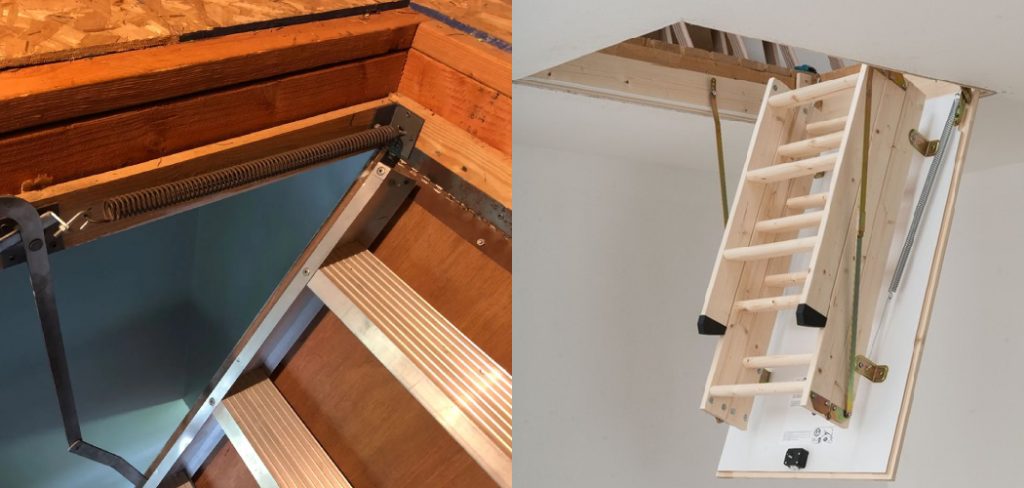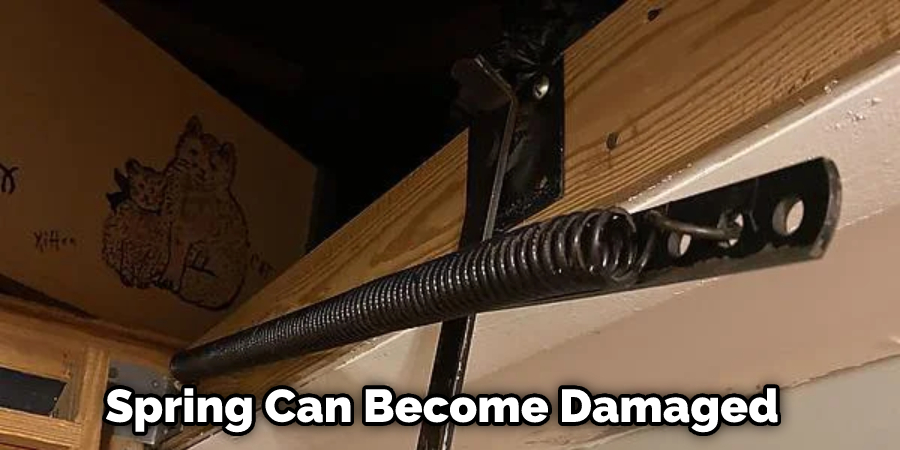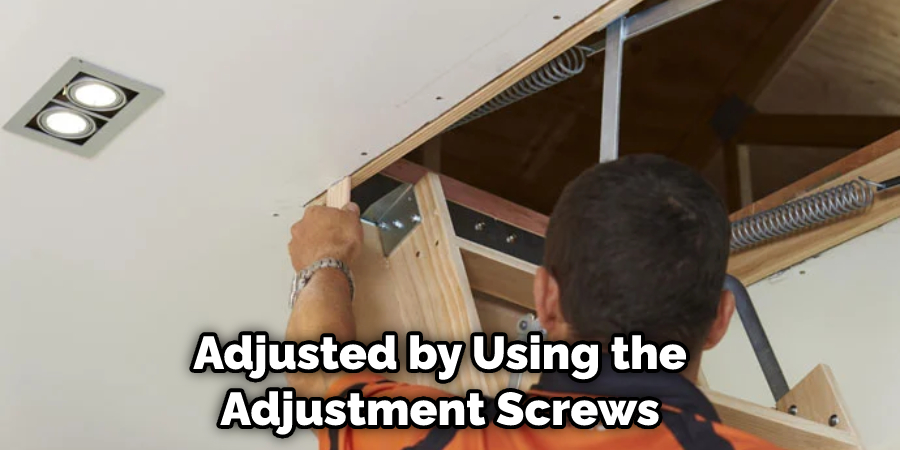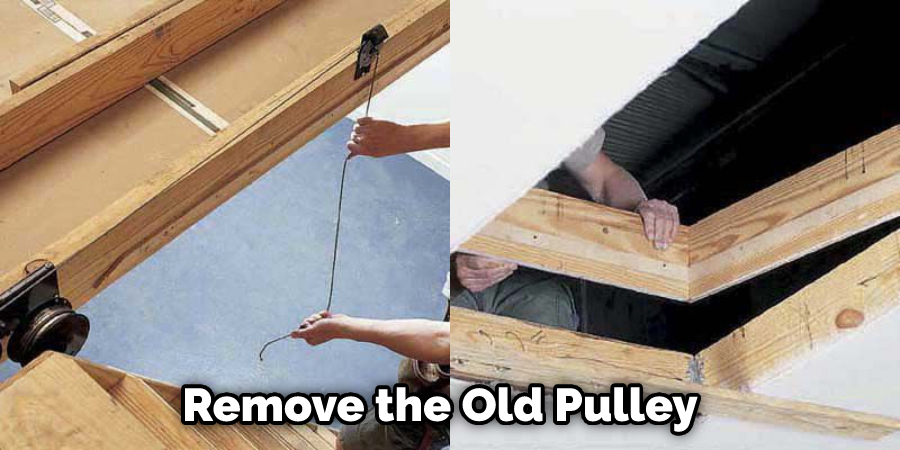If you have an attic ladder, there’s a good chance it has a spring to assist in opening and closing the ladder. Over time, this spring can wear out or break, making it difficult to open and close the ladder.

This guide will show you how to fix attic ladder spring quickly and easily. It is important to get this fixed as soon as possible, as an attic ladder that doesn’t open or close can be dangerous. Follow these simple methods to get your ladder working properly again!
Summary: Fixing an attic ladder spring requires some basic tools, a few supplies, and following a simple process. First, open the attic ladder and unhook the spring system on the ladder frame’s side. Remove any dust or dirt accumulated around the frame’s edges before replacing the spring. Secure a new spring system with screws and check to make sure it is snugly in place. Close the attic ladder and test its new spring system!
What Causes Damage to Attic Ladder Spring?
There are several reasons why an attic ladder spring may become damaged. The most common cause of damage is wear and tear. Over time, the springs can become weakened or even broken. Other causes of damage include:
Improper Installation
Sometimes improper installation can cause damage to the attic ladder spring. If the spring is not installed correctly, it can stress the wrong parts of the ladder, causing it to break or become damaged.
Incorrect Size
If an attic ladder spring is too small or too large for the ladder, it can also cause damage. The wrong size spring can put too much or too little tension on the ladder, causing it to break. And sometimes, people mistakenly buy the wrong size spring when replacing an old one.
Poor Maintenance
If an attic ladder isn’t properly maintained, it can also cause damage to the spring. For example, if the ladder is allowed to get rusty, the springs can become corrupted and weakened. Or if the ladder is stored in a damp or humid environment, the springs can become rusty or corroded.
Excessive Use
If an attic ladder is used more than is rated, the spring can become damaged. Over time, the springs will weaken from repeated use and may eventually break. Some people mistakenly believe that if a ladder is rated for 250 pounds, it can hold more than that. But that’s not the case. The weight rating is the maximum weight the ladder can safely hold, and exceeding that can cause damage to the springs.

9 Effective Methods on How to Fix Attic Ladder Spring
Method 1: Lubricate the Spring
If your attic ladder spring is squeaking or seems to be sticking, you can try lubricating it with WD-40. Simply spray the WD-40 onto the spring and work it with your fingers. This will help to reduce friction and make the spring operate more smoothly.
Method 2: Adjust the Spring Tension
If the spring tension on your attic ladder is too loose, the ladder will be difficult to open and close. Conversely, if the tension is too tight, the ladder may be difficult to open or slam shut unexpectedly. You can adjust the tension by turning the adjustment knob at the top of the ladder.
Method 3: Replace the Spring
If the spring on your attic ladder is damaged or broken, it will need to be replaced. Attic ladder springs are available for purchase at most home improvement stores. To replace the spring, first, remove the old spring and then install the new one in its place.
Method 4: Adjust the Rollers
If your attic ladder has difficulty opening or closing, the rollers may need to be adjusted. The rollers are located at the bottom of the ladder and can be adjusted by loosening or tightening the adjustment screws. And also, make sure that the rollers are properly aligned with the track.

Method 5: Clean and Lubricate the Track
If your attic ladder is not sliding smoothly, the track may be dirty or dry. To clean the track, first remove any dirt, dust, or debris with a brush or vacuum cleaner. Then lubricate the track with a silicone-based lubricant.
Method 6: Adjust the Hinges
If your attic ladder is not opening or closing properly, the hinges may need to be adjusted. The hinges are located at the top and bottom of the ladder and can be adjusted by loosening or tightening the adjustment screws.
Method 7: Replace the Rope
If the rope on your attic ladder is frayed or broken, it will need to be replaced. Attic ladder ropes are available for purchase at most home improvement stores. To replace the rope, first, remove the old rope and then install the new one in its place.
Method 8: Replace the Pulley
If the pulley on your attic ladder is damaged or broken, it will need to be replaced. Attic ladder pulleys are available for purchase at most home improvement stores. To do that, follow these steps:
First, remove the old pulley from the attic ladder. Then, install the new pulley in its place. Secure the new pulley in place with screws or nails. Test the attic ladder to ensure that it is working properly. If the attic ladder is still not working properly, you may need to replace the springs.

Method 9: Adjust the Attic Ladder
If your attic ladder is not opening or closing properly, you may need to adjust it. The first thing you should do is check the tension on the springs. If the springs are too loose, the ladder will be difficult to open and close. You can go for the instruction manual with your attic ladder to check how to adjust the springs.
How to Make an Attic Ladder Spring Last Longer?
If you want to make your attic ladder spring last longer, there are a few things you can do. First, make sure that the spring is tensioned correctly. Second, lubricate the spring with a silicon-based lubricant. Finally, if the spring shows signs of wear and tear, replace it with a new one.
There are two types of attic ladder springs, one is torsion spring, and the other is a tension spring. Tension spring is more common in household ladders. A torsion spring is a coiled wire that helps support the ladder’s weight, making it easier to open and close. Tension springs are under a lot of stress so they can break more easily than torsion springs.
If you have a torsion spring, ensure it is properly tensioned. You can do this by adjusting the set screws on the side of the ladder. If the spring is too loose, the ladder will be difficult to open and close. If the spring is too tight, the ladder could become unstable and dangerous to use.
Lubricate the spring with a silicon-based lubricant to help it last longer. You can find this type of lubricant at most hardware stores. Apply the lubricant to the parts of the spring that move when the ladder is opened and closed.
If the spring shows signs of wear and tear, it’s important to replace it with a new one. Attic ladder springs are under a lot of stress so they can break more easily than other springs. If you wait too long to replace a broken spring, the ladder could become unstable and dangerous to use.

Necessary Tips You Need to Know Before Fixing Attic Ladder Spring
- Check the weather conditions before starting to work. Because sometimes the humid and cold weather can make the springs weak. So, you should check the forecast before starting to work.
- Take all the safety measures before starting to work. Because working with springs can be dangerous, so you must take all the necessary safety precautions.
- You need to know what type of spring you have. Because there are different types of springs, each requires another type of repair.
- You need to have the right tools for the job. Because if you don’t have the right tools, you won’t be able to do a proper job.
- Make sure that you follow the instructions carefully. Because if you don’t follow the instructions, you might not be able to fix the spring properly.
- You need to be very careful while working with the springs. Because if you’re not careful, then you might get hurt.
- You need to ensure that the springs are in good condition. Because if the springs are in bad condition, they might not work properly.
- You need to lubricate the springs. Because if you don’t lubricate them, they might not work properly.
- You need to make sure that the springs are tight. Because if the springs are loose, then they might not work properly.
- You need to make sure that the springs are aligned. Because if the springs are not aligned, they might not work properly.
- You must ensure that the springs are in good working condition. Because if the springs are in bad condition, they might not work properly.
Conclusion
Attic ladders are often difficult to open and close, especially if they haven’t been used. This is because the spring mechanism can become rusty or jammed over time.
If you read the whole article, you should know how to fix attic ladder spring by now. Just remember to take all the necessary safety precautions, use the right tools, and follow the instructions carefully. If you do all of these things, then you should be able to fix your attic ladder spring without any problems.
